by Johnny Drain
This series is about oxidation, rancidity, and aging butter. Part 1 gave some background about butter, rancidity and the cultural context for eating aged butter. Part 2 explored the science of oxidation in fats and the safety of eating them. Part 3 was on culturing butters with unusual sources of bacteria. This part (finally!) is all about aging butter.
The primary aim of the project was to see if we could, by controlling the extent and pathways of aging, create butters with novel and desirable flavour profiles. Having settled on a flavoursome cultured butter, we started to carry out tests to control the conditions that lead to rancidification (as were laid out in part 2).
My hope at the start of the project was that, by letting the butter age and therefore develop mild rancid characteristics, the delicious butter cultured with our unique combination of LAB could be enhanced by some of the blue cheese and spicy notes characteristic of rancidity to give rise to an even more interesting, delicious butter: a product that, if we were to put our branding and marketing exec hats on, we might best call ‘Blue Butter’.

Figure 1. Butter samples using various, sometimes improvised, techniques to control the conditions they were exposed to.
So we exposed butter samples to a variety of different conditions for a period of up to 45 days: we vacuum-packed samples or left them exposed to oxygen in the air; we exposed samples to direct sunlight or kept them in the dark; we froze samples, refrigerated them, or kept them at room temperature. Would combinations of these processes produce notably different flavour profiles, and, more importantly, would any of these combinations offer promising gastronomic results?
Aged butters, cultured and uncultured
I ran simultaneous tests on cultured and uncultured butters, using the latter as a control for the former. The fresh uncultured butter was quite tasteless: thus, the effects on flavour of exposure to oxygen, light and different temperatures (as opposed to microbial activity) would, we hoped, be quite clearly discernible.
As expected, freezing the butters greatly slowed down any oxidation, hydrolysis or microbial activity and the flavours of these samples remained constant. Refrigeration did much the same. We corroborated these results with TBARS tests that showed only very tiny levels of oxidation products for chilled and frozen samples of both the cultured and uncultured butters (TBARS tests are a simple way to measure oxidation products, and they are discussed more fully in the addendum).
As the room-temperature butters were aged, a translucent ‘rind’ developed on their surface and various new aromas (eg. baby vomit—butyric acid!, blue cheese, Parmesan, linseed oil, petrol) and flavours (eg. blue cheese, Parmesan, linseed oil, spiciness, tanginess) developed. Furthermore, as the butters aged their texture became ‘smoother’ which was often pleasant.
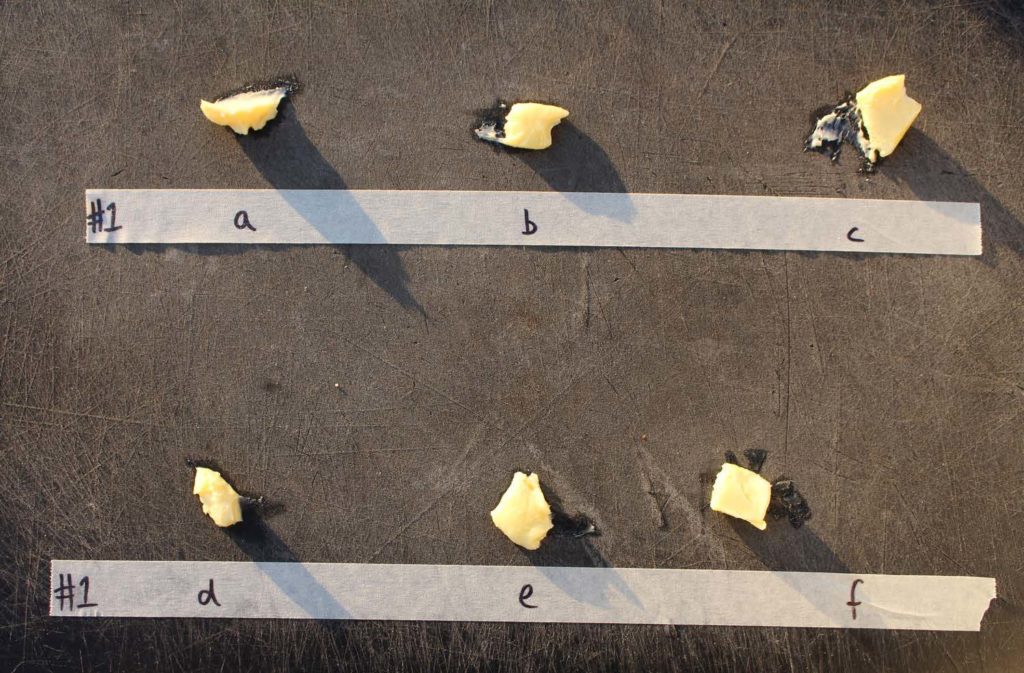
Figure 2. Aged butters ready for taste testing
For the uncultured butters there were clear differences between the flavour profiles produced by exposing the butter to atmospheric oxygen but not light and vice versa. The former gave much less palatable petrol, linseed, and beef tallow flavours, while the latter gave much more enjoyable flavours redolent of aged hard cheeses and blue cheeses. The TBARS tests supported what we intuited: that the former’s oxidation was more advanced.
The most promising results were for samples stored for ~14–28 days in dark and full or partial vacuum, or those stored for ~7–14 days in daylight and full or partial vacuum. The smens I tasted on a visit to Morocco (after I had completed this project) were very close in taste to a number of these; in particular, aged hard cheese, blue cheese and baby vomit were descriptors that cropped up when I tasted a range of smens from 3 months to 2 years old.
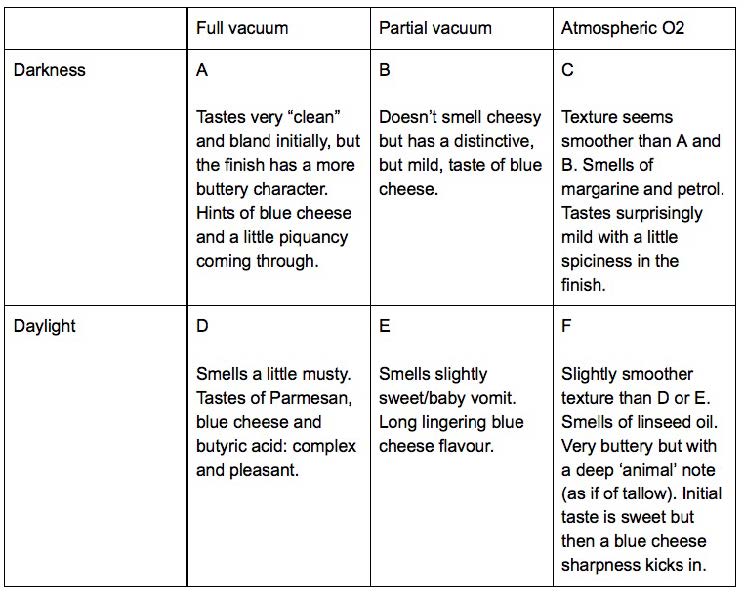
Table 1. Tasting notes for uncultured butter after aging for 14 days at room temperature under the stated conditions.
For the cultured butters, unfortunately beyond ~10 days almost all the samples developed an unpleasant bitterness/sourness as a result of continued microbial activity and/or breakdown of compounds produced by the culturing. To distinguish between the two pathways, one could pasteurise cultured butter to kill any living microbes before aging. However, regrettably, I didn’t have time to perform these further tests during my three-month stay—or rather, I tried but I always ended up with clarified butter (ghee), which has very different textural properties to unclarified butter.
Smen
As mentioned in part 1, smen is an aged Moroccan butter, normally made by mixing butter with an infusion of thyme or oregano and then storing for several months to several years in, traditionally, clay pots.
Based on the encouraging results from the uncultured butter that had been kept in a full or partial vacuum and exposed to daylight, I made smens with a variety of Nordic ingredients in place of the herbs. Although their specific function in the making of smen is not documented, oregano and thyme are packed full of antioxidants [1], as are many Danish seaweeds [2]. therefore hoped that seaweeds would work similarly well .
After 30 days, the results of the following smen infusion trials were highly mixed:
– Juniper bark—chalky, slightly soapy.
– Birch bark—resinous, sweet like candy.
– Toothed wrack seaweed—very pleasant, not a strong taste of seaweed; mild blue cheese, parmesan.
– Grass kelp—creamier and more tangy than that toothed wrack seaweed smen, and a stronger note of seaweed.
– I also made one with birch bark ash—the ash water was very alkaline—pH 13!—which caused the fat to start breaking down (saponification). The final smen had a pH of 10, which is straying towards dangerous territory so I only ate the smallest of dabs: predictably, it was soapy and unpleasant.
However, the best Nordic smen I made used bladderwrack (Fucus vesiculosus). After 15 days the bladderwrack smen tasted like a cross between a very mild blue cheese and a ranch dressing. After 30 days the blue cheese flavour had become much deeper and more rounded. I kept tasting it for up to 2 months (after which point I left the lab): throughout this period the flavour kept changing, but it remained good-tasting and, seemingly, safe. However, I suspect after 2 months in daylight it would be best to stabilise the butter by transferring it to the dark.
Seaweed smen
We served this at staff lunches melted through grains (rice, couscous or pearl barley) to which it added a complex buttery, blue cheese-like nuttiness.
25 g of crushed, dried bladderwrack seaweed
500 g fresh unsalted uncultured butter at room temperature (I also repeated this with store-bought butter (Naturmælk)
1. Infuse 500 g of water with the bladderwrack by boiling vigorously for 5 minutes. Dissolve 2 tablespoons of salt and allow to cool to body temperature.
2. In a container, pour the infusion over the butter and work them into each other. Leave overnight.
3. Strain the water off, cover and store for 2 days at room temperature.
4. Work the butter to remove any remaining water, pat the butter dry with kitchen towel and transfer to a sterilised glass jar.
5. Store at room temperature in daylight (Danish early winter daylight!).
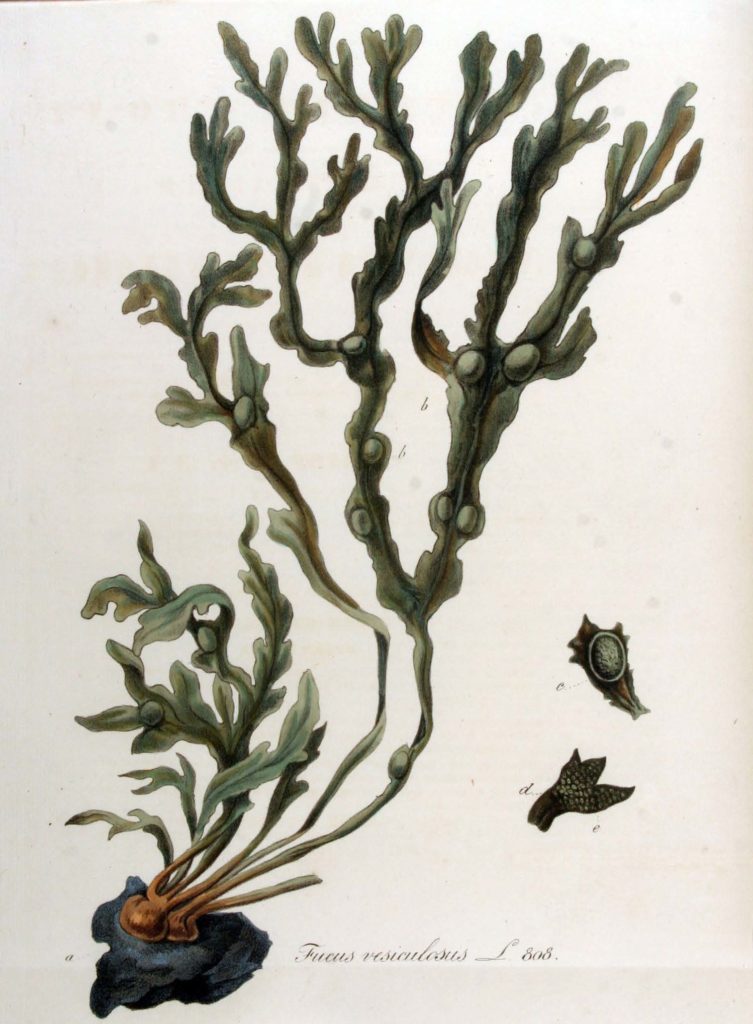
Figure 3. Bladderwrack (Fucus vesiculosus). credit.
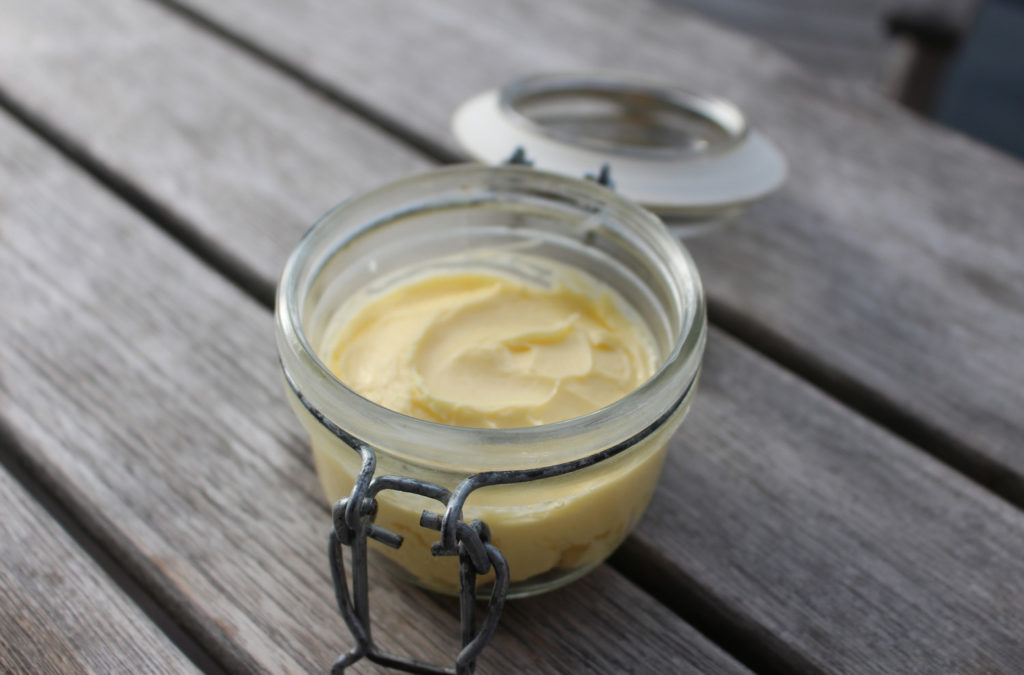
Figure 4. Bladderwrack smen, one month old
Tibetan butter tea and tsampa
Tibetan butter tea is made with Yak butter that, as mentioned in part 1, is often described by Westerners as tasting rancid [3]. In Tibet and Nepal, they also use the butter tea to make tsampa, a dumpling made with roasted barley or wheat flour. Apparently the Dalai Lama eats it everyday for breakfast! Given the plenitude of funky butters I had at my disposal I was keen to try out both of these recipes.
Of the various teas hanging around in the lab, I found the most suitable was a Thai tea, Jing Shuan Oolong Tea, which, when 10 g is brewed in 450 g water for 3–4 minutes, tastes of peach and grapefruit, and has a good astringency. To make the butter tea, I mixed 50 g of tea with 5 g of butter. The aged butter that worked best was the uncultured butter that had been exposed to light but not oxygen for 1 month.
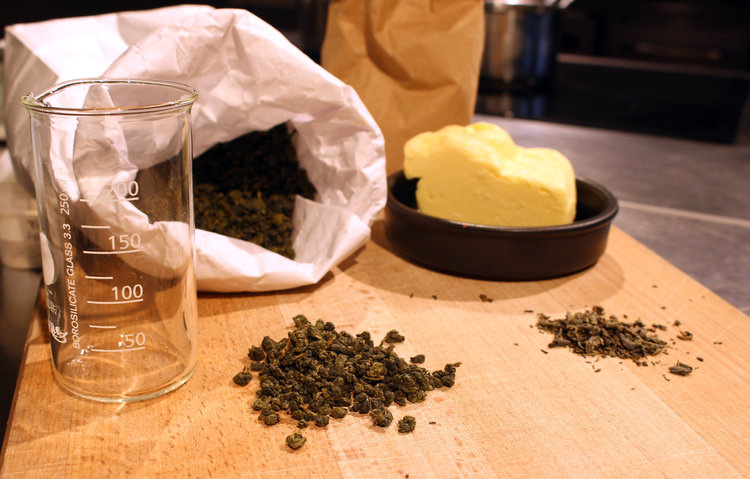
Figures 5+6. Tea, aged butter, and toasted rye flour, ready to make tsampa.
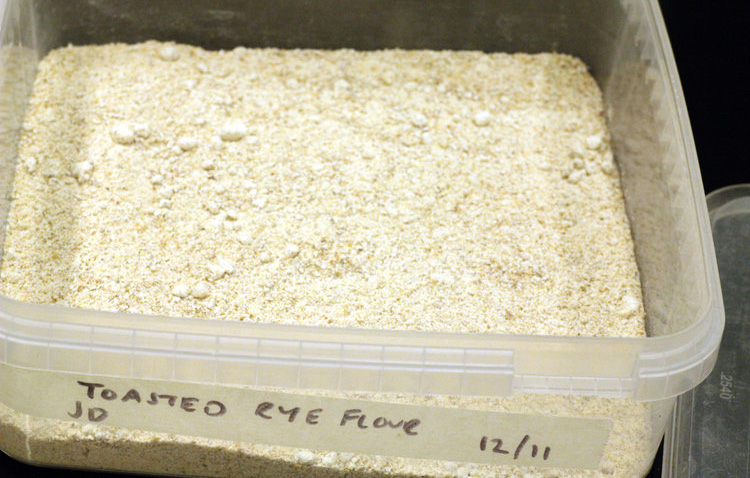
To make the tsampa, I then mixed enough butter tea with toasted rye flour to form small balls, ready to eat as they were.
The tsampa—nutty from the toasted rye, sweet and fragrant from the tea, and with a pleasing gnocchi-like texture—were quite enjoyable; I could imagine them, or some variant of them, becoming the latest go-to health craze (gluten-free, anti-oxidants from the tea etc. etc.).
In contrast, the butter tea by itself was just a bit weird. The mouthfeel was very creamy (much like bulletproof coffee), but because of its richness it was really more like a soup; for a European—perhaps especially a Briton—the name ‘tea’ jarred strikingly with my expectations of what it ‘should’ taste like.
However, pleasingly, I did find that butter tea made with aged butter was more flavoursome and palatable than that made with normal unaged butter. Gastronomically, the butter tea didn’t seem overly ripe for investigation (e.g. I can’t see it popping up on restaurant menus any time soon). Though I can easily imagine how in the challenging conditions of the Himalayas it is a very practical and soothing way of consuming energy in a very dense form.
Conclusions
Through working on this project and the process of writing these blog posts we realised that lipid rancidity is a complex topic that is, even from a chemical perspective, not wholly understood.
Although we didn’t produce any cultured aged butters that I was really happy with, the seaweed smens were great: their use as a flavour enhancer in e.g. stews, roasted meats and vegetables, grains, salads and dressings, could and should be pursued. It might be more difficult to control the aging process with already cultured butters, but with some additional trials and adjustments (e.g. pasteurisation of the cultured butter to inhibit further microbial activity, followed by aging) I am confident that a cultured aged butter with unique and delicious applications can be found.
When I started the project I was probably overly ambitious; I thought it was going to be quite easy to create some form of aged butter that I could eat with bread as an analogue of blue cheese. In hindsight that was naïve of me! After all, the great cheeses of the world have been perfected with knowledge developed over many hundreds of years. From the results of the work we did, it seems that, in whatever form it is made, an aged ‘Blue Butter’ is more likely to find use as an ingredient (e.g. used to make a beurre blanc or as per the suggested uses of the smen) rather than as a standalone product.
If anyone plays around with aging butter then please let us know; we’d love to hear about your findings.
Huge thanks to everyone at the lab who made my time there so special and particularly to Josh, Michael, Mogens Larsen Andersen (University of Copenhagen) and Kent Kirschenbaum (NYU/Experimental Cuisine Collective) for illuminating chats and guidance.
References
[1] Jorge N., Médici Veronezi, C. and Vieira Del Ré, P. (2015). Antioxidant effect of thyme (Thymus vulgaris L.) and oregano (Origanum vulgare L.) extracts in soybean oil under thermoxidation. Journal of Food Processing and Preservation. 39(6), 1399–1406.
[2] Farvin KS. & Jacobsen C. (2013). Phenolic compounds and antioxidant activities of selected species of seaweeds from Danish coast. Food Chemistry. 138(2-3), 1670–81.
[3] Tuan, YF. (1969). A Historical Geography of China, Transaction Publishers, p. 96.
Addendum: TBARS
TBARS (2-Thiobarbituric acid reactive substances) tests are a relatively simple and inexpensive chemical test used to measure the extent of oxidation in a fat. They can be performed in a standard modern chemistry lab. TBARS, which include lipid hydroperoxides and aldehydes, are naturally present in systems in which lipid oxidation has taken place e.g. oxidised fats. It is generally accepted that as the level of oxidation increases so does the amount of TBARS present.
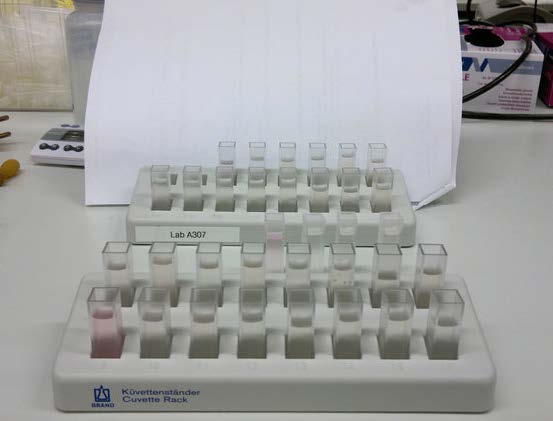
Figures 7+8. TBARS test samples: pinker samples indicate the presence of more oxidation products.
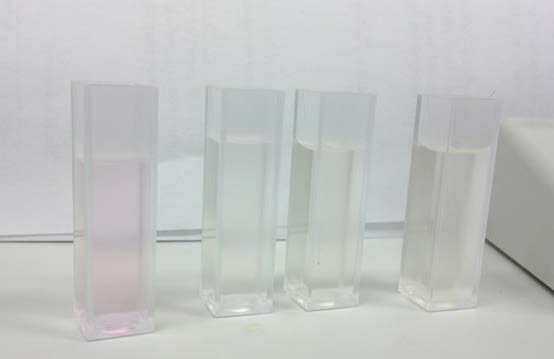
The TBARS tests gave basic quantitative support to what we intuitively expected and determined from our tasting of the butters. See Figure 9 for some representative data.
- For both cultured and uncultured butters, the chilled samples exhibited somewhat more oxidation than the frozen samples, and the room temperature samples exhibited much more oxidised character than the chilled ones.
- The cultured samples always exhibited more oxidised character than their uncultured counterparts, i.e. the presence of microbes increased oxidation (probably because of increased enzymatic oxidation).
- Samples exposed to oxygen and light exhibited more oxidised character than counterparts that had been exposed to only light or only oxygen.
- Samples exposed to only oxygen exhibited more oxidised character than counterparts exposed to only light. That is, oxidation from atmospheric oxidation was a greater problem than photo-oxidation caused by light. A practical kitchen use of this finding would be to stress the importance of storing butter and other oxidation-prone fats vac-packed, if possible.
- For the uncultured butter, after 23 days, the samples exposed to both light and oxygen exhibited more oxidised character than their counterparts, but only by a little bit more. In contrast, after 43 days, they exhibited significantly more oxidised character than their counterparts. This seemed to reflect how oxidation reactions are free radical reactions which have a slow induction period followed by rapid propagation step (and at some point a termination step). Due to time constraints I was unable to complete the TBARS tests on the 43-day-old cultured butters.
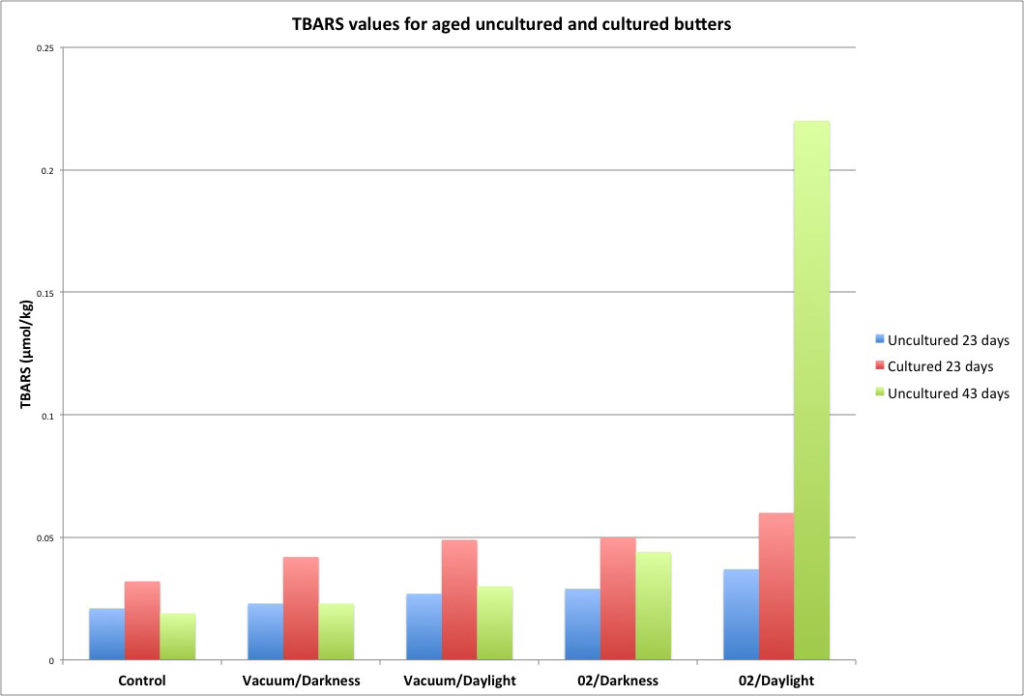
Figure 9. TBARS results for aged butters. Control samples were vacuum-packed and kept frozen in the dark. The results are based on single measurements and error bars were not calculated. However, the potential error size can be gauged from the discrepancy between the 23- and 43-day-old control samples (the 23-day-old one should contain less than or the same amount of TBARS as the 43-day-old one).
The results from the TBARS tests show that they are a useful and valid way of evaluating the level of oxidation in butter samples like these, that there are quantitative differences between butters stored in different conditions, and that these difference may ultimately be qualified through a combination of sensory studies, chemical analysis, and consideration of proposed reaction mechanisms.
